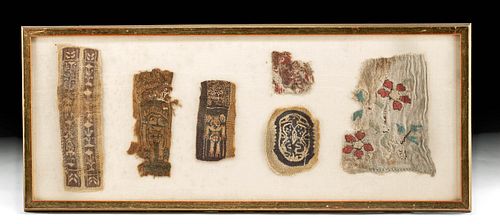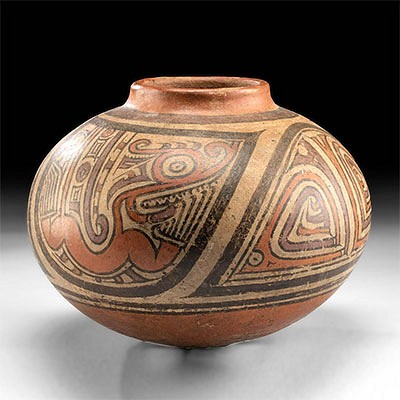6 Framed Egyptian Coptic Polychrome Textile Fragments
Lot 11a
About Seller
Artemis Fine Arts
686 S Taylor Ave, Ste 106
Louisville, CO 80027
United States
Selling antiquities, ancient and ethnographic art online since 1993, Artemis Gallery specializes in Classical Antiquities (Egyptian, Greek, Roman, Near Eastern), Asian, Pre-Columbian, African / Tribal / Oceanographic art. Our extensive inventory includes pottery, stone, metal, wood, glass and textil...Read more
Categories
Estimate:
$600 - $900
Absentee vs Live bid
Two ways to bid:
- Leave a max absentee bid and the platform will bid on your behalf up to your maximum bid during the live auction.
- Bid live during the auction and your bids will be submitted real-time to the auctioneer.
Bid Increments
| Price | Bid Increment |
|---|---|
| $0 | $25 |
| $300 | $50 |
| $1,000 | $100 |
| $2,000 | $250 |
| $5,000 | $500 |
| $10,000 | $1,000 |
| $20,000 | $2,500 |
| $50,000 | $5,000 |
| $100,000 | $10,000 |
| $200,000 | $20,000 |
About Auction
By Artemis Fine Arts
Apr 15, 2021
Set Reminder
2021-04-15 10:00:00
2021-04-15 10:00:00
America/New_York
Bidsquare
Bidsquare : VARIETY SALE | Ancient & Ethnographic Art
https://www.bidsquare.com/auctions/artemis-gallery/variety-sale-ancient-ethnographic-art-6811
Featuring classical antiquities, ancient and ethnographic art from cultures encompassing the globe. Egyptian, Greek, Roman, Etruscan, Near Eastern, Asian, Pre-Columbian, Native American, African / Tribal, Oceanic, Spanish Colonial, Russian, Fossils, Fine Art, more! Artemis Fine Arts info@artemisgallery.com
Featuring classical antiquities, ancient and ethnographic art from cultures encompassing the globe. Egyptian, Greek, Roman, Etruscan, Near Eastern, Asian, Pre-Columbian, Native American, African / Tribal, Oceanic, Spanish Colonial, Russian, Fossils, Fine Art, more! Artemis Fine Arts info@artemisgallery.com
- Lot Description
Egypt, Coptic culture, ca. 4th to 11th century CE. A wonderful framed collection of 6 different textile fragments woven with dyed cotton threads of many hues. The first and largest piece is brown and cream colored with two registers featuring stylized foliate patterns. The central four fragments all feature stylized human figures, woven in a cream, red, and blue colored threads and set into a cream or brown background. The last is a white piece with red, yellow, blue, and green floral patterns that look embroidered rather than woven. Human figures seem to have been a favorite iconography for textiles, as seen here. These fragments are from Coptic funerary robes woven in the Fayuum area of Egypt. Size of largest textile piece: 7.5" L x 2.125" W (19 cm x 5.4 cm); size of frame: 23" L x 9.5" W x .875" H (58.4 cm x 24.1 cm x 2.2 cm)
Textiles were produced by Copts and other weavers throughout the Byzantine Empire; examples like these represent some of our oldest known decorated textiles. Coptic craftsmen drew design motifs from a wide variety of images relating to life in the Eastern Mediterranean: Greco-Roman myths, pastoral scenes from the Nile River, Syrian and Persian depictions of the hunt; and celebratory or monumental civic occasions; all of these combined to make a uniquely detailed and joyful artistic tradition.
Provenance: ex-Jones collection, Boulder, Colorado, USA; ex-private Saitama, Japan collection, acquired on the Japanese art and antique market
All items legal to buy/sell under U.S. Statute covering cultural patrimony Code 2600, CHAPTER 14, and are guaranteed to be as described or your money back.
A Certificate of Authenticity will accompany all winning bids.
We ship worldwide and handle all shipping in-house for your convenience.
#163343All are fragments as shown. Discoloration and staining as expected with age. Tearing and fraying to peripheries. Motif on smallest piece is not easily indiscernible. All are mounted and stored in a modern frame. Some minor scuffs to the frame.Condition
- Shipping Info
-
All shipping is handled in-house for your convenience. Your invoice from Artemis Gallery will include shipping calculation instructions. If in doubt, please inquire BEFORE bidding for estimated shipping costs for individual items.
-
- Buyer's Premium



 EUR
EUR CAD
CAD AUD
AUD GBP
GBP MXN
MXN HKD
HKD CNY
CNY MYR
MYR SEK
SEK SGD
SGD CHF
CHF THB
THB














